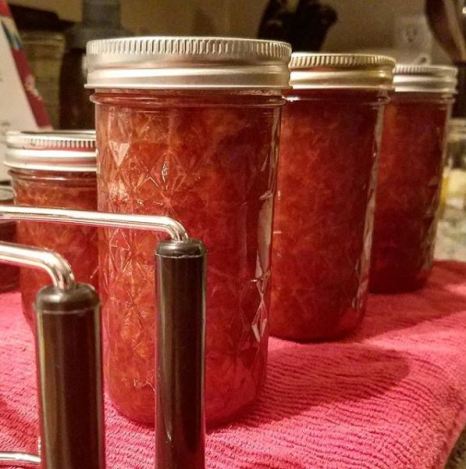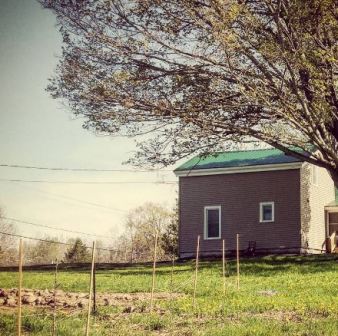Since we are a working farm, our farm stay usually requires three days of advance notice. However, we received an inquiry on the 23rd from a middle-aged woman from Switzerland named Sabine who is traveling the United States indefinitely and was looking for a place to stay overnight on the 24th en route to Vermont. Our company had just left and I had already refreshed so it was easy to say yes to her inquiry.
To say I’m glad I did is an understatement! It was an amazing experience to host someone from Europe who specifically chose to stay with us to see what family farms look like in America. I gave her a tour of our farm and shortly after she asked if she could extend her stay from one night to two. She was great company so I accepted. She was having a very restful time and then extended to a third night, and ths gave us a lot of time to talk about so many topics related to the U.S. in general as well as agriculture (sustainable and otherwise). Sabine was a retired political journalist and was journaling about the people she met and the topics that mattered to them.
A few things I found interesting and that other small farmers and homesteaders may find very interesting:
- I have never been to Europe, but Sabine shared that many people have a kitchen garden and know how to preserve their food whether by storing them in glass jars or by dehydrating. Sabine’s mother taught her to preserve without the use of refrigeration (I’m thinking of you, all of my dear off-grid homesteaders). Sabine and her late husband had a home in the Piedmont region of Italy, including a vast amount of grapes, plums, and tomatoes. She would jar enough tomato sugo to last her and her extended family for the year or longer. She would make marmalade from any fruits she harvested from her property. She would also dry many fruits.
- The United States is over-regulated (and IMHO on the wrong things). Specifically, I mean in regards to what we can and cannot sell from our farms. We made plum preserves together and she asked to purchase some when she left. She was flabbergasted to hear that while I would love to share it with her as a gift, I was not legally allowed to let her purchase the jam because in New York State there are strict regulations on home-canned goods. When she asked about purchasing dried tomatoes and apples, she was equally bothered that it was illegal for me to sell any produce that had already been cut or portioned. I would need to rent a certified, commercial kitchen in order to do this. She continually commented on how sanitary and professional my canning methods were and how she just didn’t understand why individuals can’t make decisions for themselves about whether or not they trust home-canned or home-dehydrated goods.
- People in Europe value farm-fresh goods more than Americans. (Are you surprised to hear this? I really wasn’t.) Most things are purchased through direct marketing from specialists. Local food is the norm for many people. For example, your vegetables and fruits come from a farmer, as do many preserves and pickles of any kind (unless you make them yourself). Meat comes from farmers and butchers. Fresh bread comes from bakers, many of whom use traditional sourdough methods. Sabine asked to purchase a half-dozen of eggs and when I charged her $1 she felt like I was selling myself short. In Switzerland, it is common to pay $3.50 for a half dozen of pastured eggs from a farmer. I typically charge $3.00 for a full dozen! I said that I would never be able to sell my eggs for $7/dozen here, and she said that people don’t even think twice where she comes from because they know there is a staggering difference in quality and flavor, not to mention that they value their local economies over large enterprises.
Lastly, she reminded me that our farm is a business and that while it is important to have a giving spirit I won’t have a successful business if I don’t charge what my products deserve. It can feel uncomfortable to take money from friends and family, but as small farmers, let’s all agree that we are going to stand by what our goods are worth.
Our Fall Egg CSA starts in a week, and I’m so excited and proud that I get to make my living this way. You should be, too. Let’s try to work some of that European local food appreciation into our culture!
P.S. Here is my recipe my recipe for jam with any stone fruit (apricots, peaches, plums, apricots, cherries, or a mix). My very favorite, which I made with Sabine, is made with Italian prune plums that I picked at a nearby orchard. Use freestone fruits whenever they are available because it greatly reduces prep time!

Stone Fruit Preserves (Water Bath Canning Recipe)
About 4 lb whole stone fruit
1/2 c water, reserved from boiling the fruit
Juice of 1 lemon
4 tbsp no sugar pectin
4 1/4 + 1/4 c sugar, separated
1 tsp butter
Begin by bringing a small pot of water to a boil. Meanwhile, wash the fruit and then use a paring knife to cut a small “x” into the blossom end of each fruit. When the water has come to a boil, carefully lower the fruit into the pot (in batches, depending on the size of your pot) and boil for one one minute. Cool the fruit until you can touch it.
While the fruit is cooling, combine the 1/2 cup of reserved cooking water with the juice of one lemon. In a medium bowl, measure out the 4 1/4 cups of sugar. In a small bowl, combine the additional 1/4 cup of sugar with the 4 tbsp (1/4 cup) of pectin. Combining a small amount of sugar with the pectin helps to prevent the pectin from clumping. Finally, measure an approximate tsp of butter and set aside. This small amount of butter will reduce foam.
Prepare the fruit by peeling, removing stones, and chopping to about 1/2″ square in size. Place the prepared fruit into a heavy bottomed vessel at least 5 quarts in size, such as an enameled cast iron dutch oven. Coat with the water and lemon juice. Bring to a boil, reduce to a simmer, and cook with the lid slightly ajar for about 10 minutes or until the fruit is completely cooked. You may choose to use an immersion blender for very smooth preserves (this will make more foam that you should skim off), but I prefer to simply mash the cooked fruit with a potato masher to leave some small chunks. One the mixture is at your preferred consistency, stir in the 4 1/4 cups of sugar and the butter. Bring to a boil, stirring constantly. Once it reaches a boil, stir in the sugar/pectin mixture and cook for about one minute or until the jam sets at the desired thickness. Overcooking the pectin can prevent your jam from setting, so I check the thickness by placing a spoonful on a bowl of ice in the refrigerator. This will show you how thick the preserves will be when completely cooled.
Remove from the heat and pour into sterilized jars, leaving 1/4-1/2″ of head space. (See this website on how to sterilize jars.) I then use a clean butter knife and stir the jam to remove some air, wipe the rim, place a hot lid, and twist a band to finger-tightness; this is how my mother taught me, but I’m sure there are other methods out there. Process in a hot water bath: 5 minutes for half- and quarter-pints, 10 minutes for 12-ounce jelly jars and pints. Remove from the water and cool for 12-24 hours before checking if the jars have sealed. I like to use the smaller, freezer-safe jars so that any that don’t seal can be popped in the deep freezer in our basement. I tend to use those jars first to clear that precious freezer space.


 4. Good stuff going on with the nightshades we started a week ago. So far almost all of the tomatoes have germinated, but we are still waiting on peppers, tomatillos, and eggp
4. Good stuff going on with the nightshades we started a week ago. So far almost all of the tomatoes have germinated, but we are still waiting on peppers, tomatillos, and eggp

 Based on common biointensive spacing recommendations I’ve made some hexagonal pattern templates. Using unfolded paper napkins or paper towels, which are just about a square foot in size, put dots of the paste or glue in the appropriate spots and then place your seeds. You’ll still have to thin your beets, but that’s a lot less work than thinning all of your roots and greens! I’m thinking this will make our succession planting pretty easy when the time comes, as I’ll just have to place another napkin down, cover as needed with compost, and move on.
Based on common biointensive spacing recommendations I’ve made some hexagonal pattern templates. Using unfolded paper napkins or paper towels, which are just about a square foot in size, put dots of the paste or glue in the appropriate spots and then place your seeds. You’ll still have to thin your beets, but that’s a lot less work than thinning all of your roots and greens! I’m thinking this will make our succession planting pretty easy when the time comes, as I’ll just have to place another napkin down, cover as needed with compost, and move on. Good morning! How great is it to wake up to sunshine and blue skies? Winters here are mostly grey (plus we’re in zone 5 and it’s super cold), so this weather makes for an instant good mood. We won’t be straying far from the house today but it’ll give us the chance to catch up on some chores and cooking. And I’m trying to buckle down on plans for this year’s vegetable garden.
Good morning! How great is it to wake up to sunshine and blue skies? Winters here are mostly grey (plus we’re in zone 5 and it’s super cold), so this weather makes for an instant good mood. We won’t be straying far from the house today but it’ll give us the chance to catch up on some chores and cooking. And I’m trying to buckle down on plans for this year’s vegetable garden.